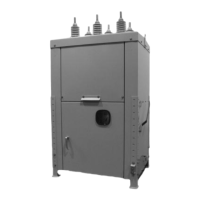6.1 DISCHARGING STORAGE UNIT CAPACITORS
The ED2.0 board provides access through KM1003 for discharging the Storage Unit
capacitors. Make sure the ED2.0 Control Board Power is removed before attempting to
discharge the capacitors.
PROCEDURE:
A 10 kOhm capacitor discharge resistor is mounted on the circuit board. Discharging is done
by jumpering KM1003 pins 5 and 6. The time constant is 33 minutes. An external resistor can
be used for quicker discharging, but the discharge current should be restricted to 10 A
maximum. This means that no lower than 10 Ohms external resistance should be used to
perform capacitor discharging. In this case an external 10 Ohm, 25 watt resistor can be
connected to KM1003 Pins 5 and 6. Approximately 30 seconds is needed to discharge the
capacitors using the 10 Ohm external resistor.
6.2 CAPACITOR LIFE
The 0.1 Farad Electrolytic capacitors are designed to be operated in the temperature range of
-40°F to 185°F. The End of Life corresponds to the point at which the capacitance decreases
by 20% or more. It is recommended that replacement of capacitors be performed every 15
years for tropical climates and 20 years for an average yearly temperature (in the outdoor
breaker enclosure) of less than 122°F.
ILLUSTRATION 5 – CB OPERATIONS VS AVAILABLE CAPACITOR CHARGE
Page 37
CIRCUIT BREAKER POSITION
CAPACITOR CHARGE CLOSE OPEN
Energy sufficient for O-CO operations Open allowed Close allowed
Energy sufficient for CO operations Open allowed Close allowed
Energy sufficient for O operations Open allowed Blocked in open position
Energy insufficient for any operation Blocked in closed Blocked in open position
position or CB
opened (depending
on dip switch setting
- I1004)
WARNING
Make sure ED2.0 Control Power is removed before attempting to discharge the
capacitors. See paragraph below.
38-929M-15A 10/15/02 1:11 PM Page 41

